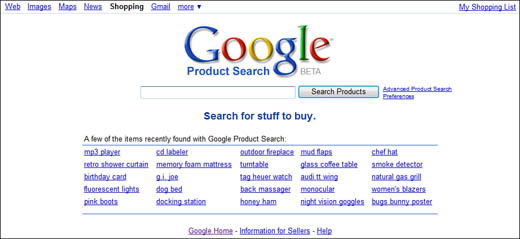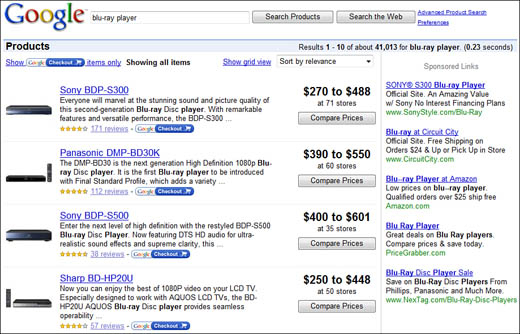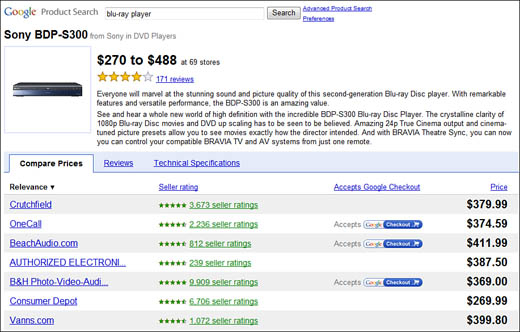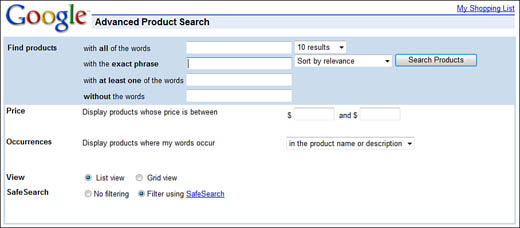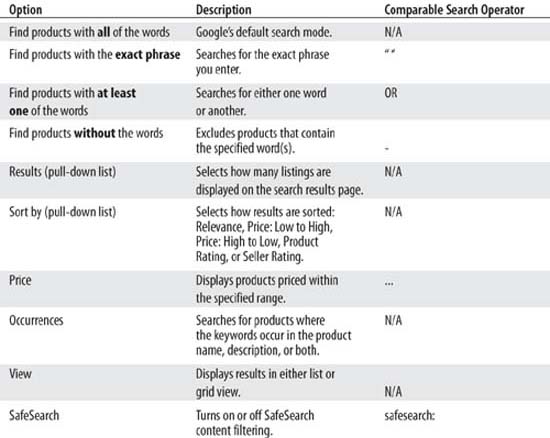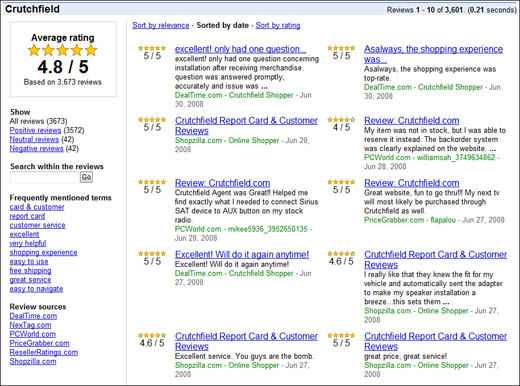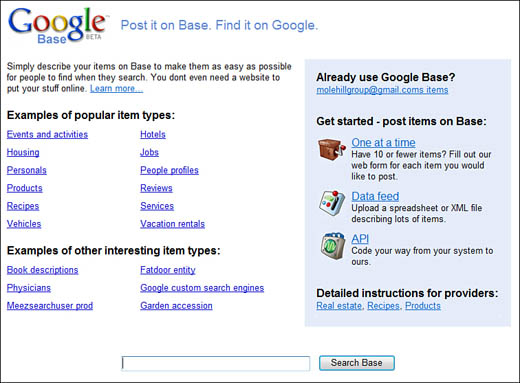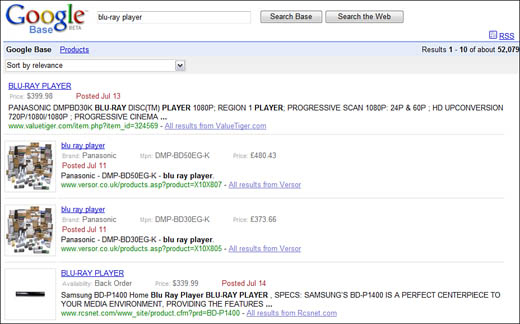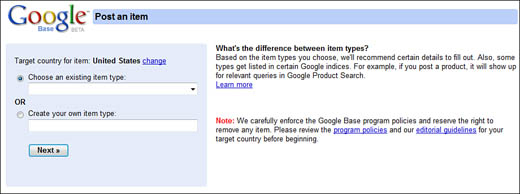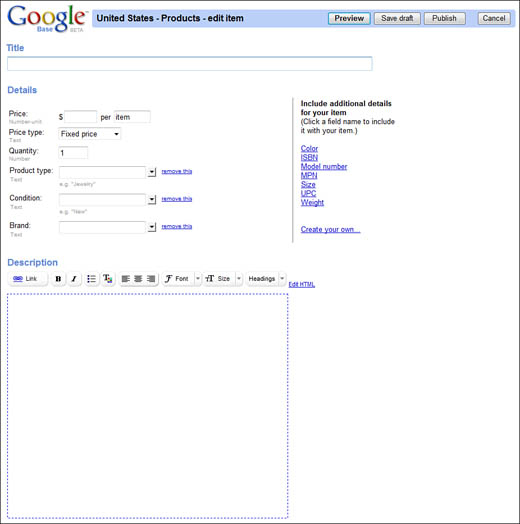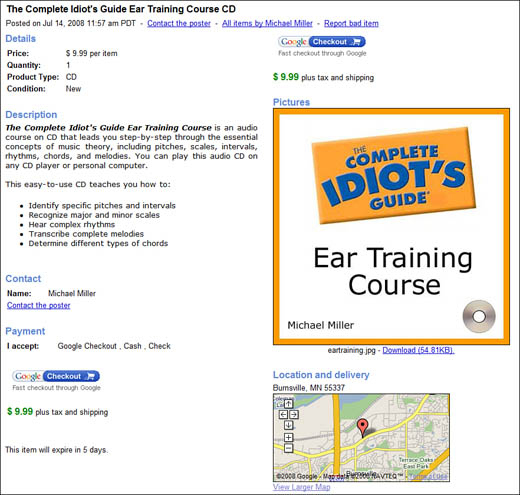If you’re looking for a pure price-comparison site, look no further than Google Product Search. This is Google’s shopping search engine, a direct competitor of all the other price-comparison sites on the Web.
Note
Google Product Search was originally named Froogle (a Googlized play on the word frugal). Froogle became Google Product Search in April 2007.
Before we get into how Google Product Search works, it might prove beneficial to first understand how the other price-comparison sites on the Web work. That’s because Google Product Search works differently from all those competing sites.
If you’ve ever used BizRate (www.bizrate.com), NexTag (www.nextag.com), Shopping.com (www.shopping.com), or a similar price-comparison site, you might be under the impression that these sites scour the Web for prices from a wide variety of online retailers. That’s a false impression; instead, these sites build their price/product databases from product links submitted and paid for by participating retailers. That’s right—most price-comparison sites charge retailers to be included in their listings. The more retailers a site signs up, the more products there are for you to search through.
To be fair, these price-comparison sites do appear to honestly present the lowest prices—from participating merchants, that is. The prices presented are legitimate, no matter who’s paying what. The only thing is, it’s possible that lower prices might exist at a retailer that doesn’t sign on to a site’s program.
Google Product Search isn’t like all the other price-comparison sites. Unique among these sites, Google is completely objective; it doesn’t take money for its listings, instead sending its spider software to independently scour the Web for merchants and products.
You see, Google Product Search is a pure search engine, just like its Google parent. Google Product Search searches all the online retailers it can find, and it doesn’t accept any paid listings. That makes Google’s price comparisons more legitimate than those at other sites. (And, in the name of full disclosure, it should be mentioned that merchants can also submit their product listings to Google—they just don’t have to pay for this privilege.)
Not only are Google’s results untainted by product placement, but it also typically returns more results for any given item you’re shopping for. That’s again because of how Google scours the Web for product listings; it’s not limited to results submitted by participating retailers. If it’s for sale on the Web, chances are Google knows about it.
Note
Retailers don’t actually pay price-comparison sites on a per-listing basis; instead, they pay when customers click their product listings. This is called a pay-per-click (PPC) model, and the individual fee is called a cost per click (CPC). CPCs run anywhere from a nickel to more than a buck, depending on the site and the product category.
The main page for Google Product Search (www.google.com/products), shown in Figure 9.1, bears more than a passing resemblance to Google’s main page. You use Google Product Search as you would Google itself, by searching for products you want to buy. (Unlike other price-comparison sites, Google offers no product category browsing capability; it’s a search-only interface.)
Because Google Product Search is an offshoot of Google, it’s no surprise that it works so well as a product search engine. In most cases, all you have to do is enter a product description, name, or model number into the search box at the top of the home page and then click the Search Products button.
Google displays all matching products on a search results page, such as the one shown in Figure 9.2. By default, the results are displayed in list view. If you click the Show Grid View link, you see the products displayed in a visual grid, which shows more items in the same amount of screen real estate (but with fewer immediate options for each listing).
Also by default, Google organizes its results based on relevance, which is measured by customer demand. You can also use the pull-down list at the top of the results listing to sort products by price (low to high or high to low), product rating, or seller rating.
Caution
Watch out for the advertisements on Google’s product search results page. These are the listings in the Sponsored Links section on the right side of the page; they’re not really search results, but rather listings paid for by Google’s advertisers.
Below the product listings is a section of search refinements you can use to narrow down the search results, as shown in Figure 9.3. These refinements differ by type of product, but typically they include filters that let you restrict your search by category, brand, price range, features, and so on. Click a link to redisplay the results as appropriately filtered.
Note
If you want to display only those items that can be purchased via the Google Checkout payment system, click the Show Google Checkout Items Only link at the top of the search results page. Learn more about Google Checkout in Chapter 33, “Selling Products and Services with Google Checkout.”
When you find a product you’re interested in, click the Compare Prices button. This displays a product page like the one shown in Figure 9.4. Here you can read a short description of the selected item, user reviews, or technical specifications. You can also compare prices at competing retailers by selecting the Compare Prices tab. You can sort this list of retailers by relevance, seller rating, price, or if they accept Google Checkout payments. (Although relevance is the default sort, sorting by price is the way to go for most bargain-shopping users.)
If you find that Google is returning too many (or too few) search results, you can use the Advanced Product Search page, shown in Figure 9.5, to fine-tune your query. This page is similar to the Google Advanced Search page; you get there by clicking the Advanced Product Search link next the Product Search box.
The Advanced Product Search page offers a number of search parameters, as detailed in Table 9.1.
Of course, you don’t have to go to the Advanced Search page to fine-tune your search. You can use any of Google’s advanced search operators to refine your search directly from the Google Product Search box.
Note
Learn more about Google’s search operators in Chapter 6, “Getting the Most Out of Google Search.”
For example, you can search for an exact phrase from the main search box by enclosing the phrase in quotation marks, like this: “sony bdp s300”. You can also exclude a word from your search by using the - sign in front of the word, or do an either/or search with the OR operator.
Caution
Google’s product prices aren’t always totally current. Because Google spiders the Web for information, the price data it collects can be several days to several weeks old. Don’t be surprised if you click a merchant link and find a different price listed, or discover that the item is no longer available.
There’s also one product-specific search operator you might want to use. The store: operator lets you limit your search to a specified online store. For example, to see what DVD players Best Buy sells, enter the query dvd player store:bestbuy. Google lists all matching products offered for sale by the specified merchant.
What do you do if you find a good price for an item on Google but have never heard of the merchant? When the quality of the merchant is as important as the price of the product, turn to Google’s merchant reviews. It’s a good way to steer your business toward reliable retailers and avoid those that underserve their customers.
Google’s merchant reviews, alas, aren’t provided by Google—or by Google’s users. Instead, they’re sourced much like all of Google’s content—by spidering the Web. Google’s spider seeks out merchant reviews at other product-comparison sites (such as PriceGrabber.com, ResellerRatings.com, and Shopping.com) and then lists and collates them for your shopping convenience. The original reviews, in most instances, are provided by customers of that retailer.
When you search for a product, the first place you see the merchant reviews is on the product detail page. Major merchants are listed with a star rating, on a scale of zero to five stars. Along with the star rating is a listing of many user reviews that merchant has received, as well as a link to view those ratings.
When you click the seller’s rating link, you’re taken to that retailer’s rating/reviews page. As you can see in Figure 9.6, this page displays the seller’s overall star rating, along with the most relevant reviews of that seller. (Relevance, in this instance, relates to reviews of products similar to those you searched for.)
Tip
Obviously, a rating has more weight the more reviews that are attached to it. A one-star rating with just a handful of reviews could imply bias on the part of a few disgruntled customers.
If the sheer number of reviews is overwhelming, you can click the appropriate links to
-
Show positive reviews only
-
Show neutral reviews only
-
Show negative reviews only
-
Sort reviews by relevance, date, or rating
Tip
I find it useful to focus on a seller’s negative reviews, to see if there are any recurring problems noted. If a seller has a history of slow shipping, for example, this will probably show up in multiple reviews.
Google displays only the first few lines of these merchant reviews. To read a full review, just click the review title link. This takes you to the original review on its original website. (You can also go to the main page of the reviewing website by clicking the site’s name in the Review Sources section of the left column.)
Commentary
Google Product Search isn’t the only way to find products for sale on the web. Google also offers Google Base, a service that’s not easy to describe. Some have described it as a site for online classified ads, like the increasingly popular craigslist. Others have described it as an online marketplace, kind of like eBay without the auctions. Still others view Google Base as a giant database of products and information—and this description probably is the most accurate.
Google describes Google Base as “a place where you can easily submit all types of online and offline content that we’ll host and make searchable online.” That sounds a lot like a big database to me—which is, presumably, where Google got the Google Base name. You can use Google Base to post items you want to sell; other users can search the Google Base database to find items they want to buy. When a match is made, you and the other user arrange payment and shipping between yourselves. (That’s why some say Google Base is a lot like eBay, because eBay is also a “middleman” to individual transactions between users.)
Okay, so it’s probably best to think of Google Base (base.google.com) as a giant database of products and services. As Google says, the goal of Google Base is to “collect and organize information and to expose it to the world.” Of course, most of the “information” that Google talks about is actually physical products for sale by owner; the amount of free information offered in Google Base is a small subset of the total listings.
The reason that Google talks about collecting information is because that’s exactly what it collects—information about physical products for sale, as well as other offline and online content. Google deals in the information about the items for sale, not in the items themselves.
The nice thing about Google Base is that it’s a totally free service for both buyers and sellers. Items you post for sale on Google Base are available to users of the Google Base site. Depending on their relevance (that is, their popularity vis-à-vis links from other websites), they may also appear on Google proper, Google Product Search, or Google Maps.
What kinds of items can you post on Google Base? Obviously, you can post information about physical items you’re selling, from clothing to cars and just about anything in between. You can also post nonphysical items for sale, such as poems, short stories, informational guides, recipes, electronic books, digital artwork, and the like. You can even post items or information for free distribution; Google Base doesn’t have to be just for selling.
Note
When you post an item on Google Base, you describe it by assigning multiple keywords in the form of labels and attributes. Think of a label as the major product category (automobile, clothing, short story, and so on) and attributes as subcategories or descriptors (Ford, Explorer, automatic, red, and so on). Potential buyers use these attributes to fine-tune their searches.
And you can choose how—or, more precisely, where—you sell or distribute your items. If you want to use Google Base as a classified advertising service to sell items for local pickup or delivery, you can. If you want to offer items online for shipment anywhere in the country (or the world), you can. It’s your choice.
After you’ve posted an item, it’s available for searching by other Google Base users. It’s possible that your item will also show up on Google proper (or on Google Product Search or Google Maps), but don’t hold your breath. It has to build up relevance the old-fashioned way, via lots of links from other sites, before Google adds it to its normal search index.
As you can see in Figure 9.7, the home page for Google Base includes a handful of clickable product categories, links for uploading your own items, and the ubiquitous search box, now located at the bottom of the page. You can find items either through searching (no surprise) or by clicking through the product categories.
Searching for items on Google Base is just like searching for items on Google proper, with the addition of search refinements based on the user-assigned attributes we discussed previously.
To conduct a product search, all you have to do is enter your query into the top-of-the-page search box, and then click the Search Base button. Google Base displays an initial search results page, as shown in Figure 9.8. Unfortunately, the results on this page are probably too broad to use, because it lists all the items posted in all product categories.
When you want to find out more about a particular item listing, click the title of the listing; this takes you directly to the product page, often hosted off-Google at a third-party site. If you then choose to purchase the item, you arrange payment and shipping directly with the seller. Your interaction with Google Base is now over.
Okay, now you know how you can search for and purchase items on Google Base. But what if you have something to sell? Read on to learn how to post your items for sale on the Google Base system.
Creating a listing with Google Base is a relatively easy process. All you have to do is follow these steps:
-
From the main Google Base page, click the One at a Time link.
-
The next page, shown in Figure 9.9, prompts you to select an item type. This should be the main product category for your listing. You can probably find a category that fits by pulling down the Choose an Existing Item Type list; if not, enter a new category into the Create Your Own Item Type box. Click the Next button to continue.
-
The next page, shown in Figure 9.10, is where you enter all the details about what you’re selling. Although the specific details will vary by item type, you’ll probably be asked to enter the item’s title, price, price type (fixed price, minimum price, or negotiable), quantity, product type, condition, brand, and a detailed item description.
-
For some items, you see a section for additional details about your item, typically to the right of the Details section. Click any or all links in this section to provide the appropriate details. (For example, if you’re selling an article of clothing, click the Apparel Type link; this displays a new Apparel Type list box in the Details section.)
-
Still on the same page, scroll down to the Pictures and Files section and add up to 10 photos of your item. You can add a picture hosted on another website by entering the photo’s complete URL, or you can click the Browse button to upload pictures stored on your PC. Click the Attach button after you’ve entered the information for each photo.
-
Still on the same page, scroll to the bottom of the page and check your Contact, Payment, and Location and Delivery information. Click the appropriate Edit link to change any of this info.
Note
Most Google Base sellers sign up to accept payments via Google Checkout. Learn more about Google Checkout in Chapter 33, “Selling Products and Services with Google Checkout.”
-
Still on the same page, enter how long you want this listing to last into the This Item Will Expire in XX Days field. Your listings can run a maximum of 31 days.
-
When you’re done entering information, click the Preview button to preview your listing or the Publish button to finalize and post your listing.
The resulting listing, like the one shown in Figure 9.11, is now live. Good luck with the selling!
The process previously described is the way to list individual items for sale. But if you have a lot of items to post, you’re better off using Google Base’s bulk upload function. You can prepare your list of items offline and then upload them all in a single file.
For bulk uploading, Google accepts information in either tab-delimited spreadsheet or XML (RSS 1.0, RSS 2.0, Atom 0.3, or Atom 0.2) formats. To upload a file of listings, go to the Google Base home page and click the Data Feed link. When the next page appears, click the New Data Feed button, and then follow the onscreen instructions to upload the designated file. See base.google.com/base/howtobulkupload.html for more information on how to create the bulk upload file.
Here’s another use for Google Base—it lets retailers submit their store inventory for inclusion in the Google Product Search database. You can use Google Base to submit both online and retail inventory, which means you can then use Google Product Search to drive traffic to your local location.
The best thing about this is that it’s the identical process used to upload bulk postings to Google Base. To submit store inventory to Google Product Search, all you have to do is create and submit a bulk-upload file to Google Base.
We’ll talk more about Google Maps in Chapter 27, “Finding Your Way with Google Maps.” If you want information about your local business to be included in the Google Maps database, you can use Google Base to submit that information.
Again, the process to upload business location data is the same for submitting any bulk upload file to Google Base. You need to create a file with your business location information (in tab-delimited or XML format) and then upload that file from the Google Base main page.

